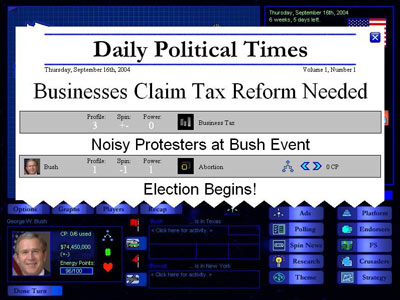Poll Dancing
All of the election games have real-world information under the hood, but they build the gameplay on it to varying degrees. At the very least, they use census data, polls, and past election records to model how people will vote. Some of the games log onto a server when you play, downloading the latest data. For instance, Randy Chase updates Power Politics III twice a week based on the latest polls. "The entire game engine was designed to be an evolving growing experience," he says. "Unlike the first two versions of Power Politics, we are no longer limited to a fixed product fed into the retail channels. The game client can be updated by our servers as needed, and all the key data resides on the server instead of a CD-ROM. This provides a fluid and dynamic foundation that provides unlimited opportunity for growth and expansion."
But some things are harder to model than others. For instance, the vagary of voter turnout is a difficult issue that plagues real-world polls. A lot of the divergence among recent polls has to do with how or whether a pollster defines 'likely voters.' It's easy enough to call a thousand people and ask them who they'll vote for; it's not so easy to extrapolate from this how many people will actually vote on November 2nd. This partly explains why some polls show Kerry and Bush in a dead heat while others show a clear leader by several percentage points. Wardell thinks he underestimated this issue of voter turnout when he made The Political Machine. "I think in any sequel, I could focus more on that, on what things you can do to make more people turn out. Everyone keeps talking about the importance of swing voters and I think I bought into that a bit too much. I really think now that turnout of the base matters."

President Forever
"In the end," says President Forever's Anthony Borgoyne, "we found you just have to ask yourself whether the model feels right. In other words, this is not a science yet." He notes that even the basic mechanics of our election process might be changing. "We will soon know if we have now entered an era where legal litigation along the lines of the Supreme Court case Bush v. Gore is now the standard final part of a close election. If so, we will have to update President Forever's game engine." John Gastil notes that his game, Election Day, wasn't prepared to deal with incidents like Florida 2000. "The previous version has such a result occasionally, but we debugged it," he wryly notes.
Of course, no election game is trying to model every single element of a campaign and election. A big part of game design is determining how much and how little to re-create from the real world. "The most challenging thing for us was trying to capture all the nuances of an election, the spin doctoring and the candidates, without drowning the player in data," Paul Schuytema says of Frontrunner. "We purposefully worked to abstract things into a simple and interesting approach."


